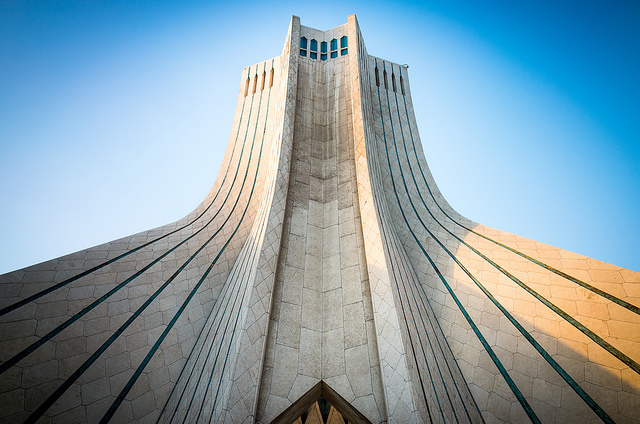
America’s new President seems to be painting himself into a corner. The Muslim travel ban has misfired with one court decision after another challenging the rationale that it was necessary in order to provide security to the American people. Additionally, in a severe indictment of the travel ban several former senior officials, including secretaries of State and Defense, have issued a joint statement that says the ban ‘undermines’ national security and will ‘endanger U.S. troops in the field.’ His plan to build a wall on the Mexico–US border and make Mexico pay for it has also been a non-starter.
In that context, the recent Iranian missile test has provided the beleaguered American president with an opportunity to break out of his isolation by pandering to the patriotic instincts of the American people. That’s a tried and tested strategy—since the Iranian Revolution of 1979 the dominant narrative in the US has portrayed Iran as a permanent enemy. It has, therefore, become a convenient punching bag for American politicians of all hues.
It’s no wonder that President Trump has also fallen into that trap. He began by declaring after the missile test that he’d put Iran ‘on notice’. He then followed his statement up with a set of sanctions aimed primarily at the Iranian Revolutionary Guard. The main significance of the sanctions isn’t that they hurt Iran economically—the latest sanctions do so only to a limited extent—but that they signal a radical escalation in the level of Washington’s hostility toward Tehran and that at a time when both the United States and Iran need each other to fight the twin menace of state failure and radical Sunni jihadism in the Middle East.
The Trump administration has argued that by undertaking the missile test, Iran has violated UN Resolution 2231, passed in 2015, in which the Security Council endorsed the nuclear deal, known formally as the Joint Comprehensive Plan of Action (JCPOA). However, it simultaneously ‘called upon’ Iran ‘not to undertake any activity related to ballistic missiles designed to be capable of delivering nuclear weapons’.
The wording was left deliberately vague in order to gain the acceptance of all parties to the nuclear deal. In a stark contrast to UN Security Council Resolution 1929, from 2010, which said that the Security Council ‘decides that Iran shall not undertake any activity related to ballistic missiles capable of delivering nuclear weapons’, the latest resolution merely ‘called upon’ Iran not to do so.
Moreover, the context of the two resolutions was radically different. Resolution 2231 was passed by the Security Council in the aftermath of the Iran nuclear deal, in which Tehran committed itself to freezing its nuclear weapons program, sending much of its enriched uranium abroad and decommissioning the Arak heavy water plant thus foregoing the plutonium route to the bomb. That has now allowed Iran to argue that its missile tests have nothing to do with nuclear weapons since it voluntarily dismantled its nuclear weapons program.
The tension between Iran and the US, however, goes beyond the recent missile test. There’s a fundamental disjuncture between American perceptions of Iran and the latter’s perception of itself. Washington needs to take account of that discrepancy if it’s seriously concerned about improving relations with Tehran, which is essential for the long-term security and stability of the Persian Gulf region.
Tehran considers itself a status quo power in the Middle East and points to its support for the Iraqi and Syrian (and now the Lebanese) regimes as evidence of that fact. That, according to the Iranians, should endear it to the US, which has generally opposed radical change in the region. Tehran claims that it’s Saudi Arabia, and to a lesser extent Turkey, that are responsible for disturbing the status quo in the Middle East and creating mayhem and anarchy in the region.
Furthermore, Iran points to the convergence of American and Iranian interests in Iraq where both are committed to keeping the country unified and defeating ISIS. Iran’s status as a predominantly Shia state means that it takes seriously its role in ridding the world of the ISIS menace. In fact, the US and Iran have followed parallel policies in Iraq in supporting the government forces and the pro-government militia in combating ISIS.
Iran also points to the fact that no Iranian national has committed an act of terror in the American homeland, while 15 of the 19 9/11 hijackers came from Saudi Arabia. Jihadi terrorism, it argues, is an offshoot of Saudi Wahhabism, which is anathema to Shia Iran and is a common enemy of both Iran and the US.
Those are strong arguments that the Trump administration shouldn’t ignore. It’s commonly acknowledged that no lasting structure of security can be established in the energy rich region without the participation of the pre-eminent global power, the US. The same applies to Iran because by its size, demography, military capabilities, and industrial and technological resources, it’s the pre-eminent power in the Gulf. As The Washington Post states in the context of the latest crisis in American-Iranian relations, ‘Now the United States will be facing down a far stronger Iran, one that has taken advantage of the past six years of turmoil in the Arab world to steadily expand its reach and military capabilities.’
Both Washington and Tehran need each other in order to provide stability to the Persian Gulf. It’s time, therefore, that both parties work towards overriding temporary concerns regarding domestic popularity or technical differences over interpretations of Security Council resolutions.

